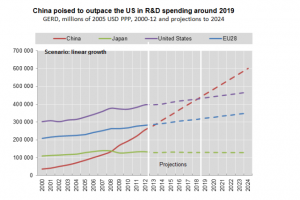China to Triple Patents by 2020 as R & D Spending Overtakes the US and EU
While it is good for China to set targets, it is more important to 1) scrutinize the quality of patents registered in China; 2) steadily raise the proportion of Chinese patents registered internationally; and 3) translate those patents into usable technologies, an area in which China lags badly behind the US. China’s IP protection has improved significantly over the past few years and will continue to do so into the next decade so one can only hope that with quantity comes quality and utility.
Most important is how much countries are devoting to R & D. According to a recent OECD study, China surpassed the EU28 in S & T spending in 2013 and is expected to leap-frog over the US by 2018. The two graphs below illustrate the dramatic trend. But, as with patent numbers, China needs to convert that spending into tangible results to become a truly great innovation power.
Meanwhile, a Washington Post article laments the decline of US innovation: http://www.washingtonpost.com/opinions/fareed-zakaria-the-need-to-renew-american-innovation/2015/01/01/b0f0d864-913b-11e4-a900-9960214d4cd7_story.html
———-
China is aiming to triple the number of patents it files by 2020 as Beijing looks to boost the country’s high-tech economy in areas from agriculture to pharmaceuticals, according to a notice from the central government on Sunday.
China is targeting 14 invention patents per 10,000 habitants by 2020 compared to four in 2013. It published 629,612 patents in 2013, over 200,000 more than the United States, according to a Thomson Reuters study in December.
Beijing wants to become a bigger player in high technology industries as the country grapples with slower growth and rising costs for its manufacturing base. This is likely to raise a challenge to global players operating in China and abroad who have typically dominated in more innovative sectors.
“Intellectual property (IP) is increasingly becoming a vital component of China’s strategic resources and competitive ability,” the statement posted on the Central People’s Government website said.
It added that by 2020 China would have boosted its legal environment for IP protection and management, often an area of contention for foreign firms who say that IP law in China sometimes favors local players.
Beijing is also looking to reduce the length of the review process for patent and trademark applications. Patent reviews will decline to 20.2 months in 2020 from 22.3 months in 2013, while trademark reviews will fall to 9 months from 10 months.
– Reuters
Source: OECD Science, Technology and Industry Outlook 2014.
The press release can be seen at: http://www.oecd.org/newsroom/china-headed-to-overtake-eu-us-in-science-technology-spending.htm



0 Comments
Trackbacks/Pingbacks